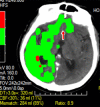Endovascular thrombectomy for large vessel occlusion acute ischemic stroke after cardiac surgery
- PMID: 36335602
- PMCID: PMC10100038
- DOI: 10.1111/jocs.17082
Endovascular thrombectomy for large vessel occlusion acute ischemic stroke after cardiac surgery
Abstract
Introduction: Acute ischemic stroke (AIS) can be a catastrophic complication of cardiac surgery previously without effective treatment. Endovascular thrombectomy (EVT) is a potentially life-saving intervention. We examined patients at our institution who had EVT to treat AIS post cardiac surgery.
Methods: We retrospectively reviewed a stroke database from January 1, 2016 to October 31, 2021 to identify patients who had undergone EVT to treat AIS following cardiac surgery. Demographic data, operation type, stroke severity, imaging features, management and outcomes (mortality and modified Rankin Score (mRS)) were assessed.
Results: Of 5022 consecutive patients with AIS, 870 underwent EVT. Seven patients (0.8%) had EVT following cardiac surgery. Operations varied: two coronary artery bypass grafting (CABG), two transcatheter AVR, one redo surgical aortic valve replacement (AVR), one mitral valve repair and one patient with combined aortic and mitral valve replacements and CABG. Meantime postsurgery to stroke symptoms onset was 3 days (range 0-9 days). Median NIHSS was 26 (range 10-32). Five patients had middle cerebral artery occlusion and two internal carotid artery (n = 2). Median time between onset of symptoms and recanalization was 157 min (range 97-263). Two patients received Intra-arterial Thrombolysis. All patients survived and were discharged to another hospital (n = 3), home (n = 2), or rehabilitation facility (n = 2). Median 3-month mRS was 3 (range 0-6).
Conclusion: We report the largest case series of EVT after cardiac surgery. EVT can be associated with excellent outcomes in these patients. Close neurological monitoring postoperatively to identify patients who may benefit from intervention is key.
Keywords: cardiovascular pathology; cardiovascular research; coronary artery disease; valve repair/replacement.
© 2022 The Authors. Journal of Cardiac Surgery published by Wiley Periodicals LLC.
Conflict of interest statement
The authors declare no conflict of interest.
Figures










References
-
- Head SJ, Milojevic M, Daemen J, et al. Stroke rates following surgical versus percutaneous coronary revascularization. J Am Coll Cardiol. 2018;72(4):386‐398. - PubMed
-
- Schweizer R, Jacquet‐Lagrèze M, Fellahi JL. Cerebrovascular complications after cardiac surgery: it is time to track and treat large vessel occlusion. J Thorac Cardiovasc Surg. 2020;159(4):e263‐e264. - PubMed
-
- Goyal M, Menon BK, van Zwam WH, et al. Endovascular thrombectomy after large‐vessel ischaemic stroke: a meta‐analysis of individual patient data from five randomised trials. Lancet. 2016;387(10029):1723‐1731. - PubMed
-
- Nogueira RG, Jadhav AP, Haussen DC, et al. Thrombectomy 6 to 24 hours after stroke with a mismatch between deficit and infarct. N Engl J Med. 2018;378(1):11‐21. - PubMed
MeSH terms
LinkOut - more resources
Full Text Sources
Medical

